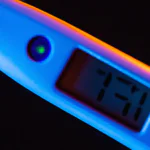If you’ve been trying to decide between using an ear thermometer or a non-contact thermometer, you’re in the right place! Let’s explore the accuracy and benefits of each type of device. We’ll answer some of the common questions about ear thermometers, including why they may give a higher reading than head thermometers and when they should not be used.
Table of Contents
Are Ear Thermometers Accurate?
When it comes to getting a person’s body temperature, accuracy is key. The most accurate method of taking a person’s temperature is to use a rectal thermometer. Many people may find this method too uncomfortable, so what are the other options?
Forehead scans can be just as accurate as rectal temps, but they require a special thermometer. Oral and ear thermometers are also an option, as long as they are used correctly. Ear thermometers were once considered to be one of a doctor’s most reliable tools.
But, how accurate are ear thermometers really?
It depends on the user. How the thermometer is calibrated at home or in the doctor’s office makes all the difference. Also consider that factors like air conditioning, eating or drinking something warm or cold, all have an effect on accurate readings.
Here is a quick list of reasons that might affect the accuracy of an ear thermometer:
- Calibration: Ear thermometers need to be calibrated properly according to manufacturer instructions.
- Positioning: Ear thermometers must be placed correctly in the ear canal in order for an accurate reading.
- Infections: If there is an infection or blockage in the ear canal, this could cause a false reading.
- Earwax: Make sure to clean out any excess wax that may be blocking the reading.
- Air Temperature: Remember to adjust the settings if you’re in a room with temperature changes.
Keeping these factors in mind should help you get more reliable results from your ear thermometer. While it isn’t quite as accurate as some other methods of taking body temperature, it can still provide reasonably reliable results.
Uncovering the Truth: Why Ear Thermometers Read Higher
An ear thermometer is a device specifically designed to read the temperature inside of a person’s ear canal, and it can get a more accurate reading than other types of thermometers. However, the infrared sensor that is used in this type of device is incredibly sensitive – if the probe cover is missing or broken, it will usually register a higher temperature than normal.
Since the infrared sensor is designed to detect body heat, any heat that is present within the ear canal when the thermometer is used can cause an incorrect reading. This can be due to things such as wax buildup, or even just the heat of the walls of the ear canal. When the probe cover is damaged or absent, those extra forces of heat can interfere with the accuracy and result in higher readings.
To ensure your ear thermometer provides accurate readings each and every time you use it, it’s important to make sure you’re using it with a probe cover intact. Probe covers are made from non-conductive material, so they won’t interfere with the infrared sensor like damaged or missing covers might.
In addition to probe covers, there are some tips you can use to reduce any excessive heat that may be present in your ear:
- Avoid putting your hand or an object into your ear canal before taking your temperature.
- If you’re dealing with wax buildup, be sure to soften it up before using your thermometer.
- Make sure your ears are cool before using your thermometer.
By keeping these tips in mind and checking for a proper probe cover each time you use your thermometer, you’ll enjoy accurate readings – no matter what type of thermometer you own.
Ear Thermometers vs. No-Touch Thermometers: The Showdown
Taking your child’s temperature is an important part of monitoring for any sickness and keeping them safe. With the recent advancements in technology, there are now a variety of options with different types of thermometers suited for kids. But which type is best? Ear or no touch thermometers can both provide accurate readings, but there are a few key differences that make one better depending on the situation.
An ear thermometer can provide extremely accurate readings with older children who don’t mind having the thermometer being placed in their ears. They are fast and easy to use but some kids may be scared, so it’s important to explain why taking the temperature is necessary.
For parents with younger children, a forehead thermometer is ideal. It’s gentle and non-intrusive and most kids won’t be scared of it. This kind of thermometer works by scanning your child’s forehead using an infrared light.

Which type should you choose?
When deciding between an ear and forehead thermometer, consider age and comfort level of the child:
- Ear Thermometer: Ideal for older children who don’t mind having the thermometer placed in their ears.
- Forehead Thermometer: Best for younger children as it is gentle and non-intrusive.
Both types of thermometers use advanced technology to take accurate readings and so either can be a good choice depending on what will work best for your family. Consider age, comfort level, and ease-of-use when making your decision.
The Age Factor: At What Age are Ear Thermometers Accurate?
Ear thermometers provide an easy and non-invasive way to measure a child’s temperature. While modern ear thermometers are fast and easy to use, they are not always accurate with children under the age of six months. After 6 months when babies have fully developed ears, ear thermometers can be used to get a more accurate reading.
Infants up to 4 years old cannot accurately have their temperature taken using an ear thermometer. It is recommended to instead use a rectal thermometer for infants and young children, as it is the most accurate method for taking their temperature.
When taking a rectal temperature reading on an infant or young child, it’s important to take into consideration how uncomfortable your baby may be in that position. Here are some tips for taking the temperature safely and comfortably for your little one:
- Lubricate the tip of the thermometer. Apply petroleum jelly or any water-soluble lubricant on the tip before you insert it. This allows for easier insertion and limits discomfort that could be caused by friction.
- Hold the baby in place securely. Make sure you wrap them up tightly in their swaddling cloth or blanket before attempting to take their temperature. This will ensure they have the right support and won’t move too much while the thermometer is inside.
- Wait patiently. Take your time and be patient as you wait for an accurate reading. Keep talking to your baby throughout the whole process.
patience and gentle care should be taken when measuring an infant’s temperature by any method.
Head Temperatures vs. Ear Temperatures: Which is More Accurate?
When it comes to taking a temperature, there are several options one can consider. It is important to note, however, that accuracy varies depending on which method you choose. Here’s a guide to the most reliable temperature-taking methods.
Rectal
Rectal temps are widely considered to be the most accurate of all the temperatures. Since rectal temps measure the core body temperature directly, they are considered by medical professionals to be the gold standard in basis for comparison.
Forehead
Forehead thermometers use infrared technology to detect temperature from the temporal artery. While not quite as accurate as rectal temps, forehead thermometers are still considered the next best option and are generally used for people of all ages.
Oral & Ear
Oral and ear temps can also be very accurate if done properly. Both of these types of measurements involve taking a temperature reading directly from a body cavity – either inside the mouth or in the ear canal. However, for both to be reliable, proper technique is essential.
Armpit
- Finally, armpit temperates are least reliable since they measure skin temperature rather than body core temperature. As such, they should only be used when other methods are unavailable or difficult to perform.
When it comes to measuring temperatures with accuracy and reliability, rectal and forehead temperatures lead the way. Oral and ear thermometers also provide reliable readings if done properly while armpit temps should only be used when other methods cannot be employed.
When No-Nos Apply: When Should an Ear Temperature Not Be Taken?
An ear thermometer should not be used on infants who are 6 months old or younger. This is due to their ears still being in a vulnerable state, and immature structures that can be easily damaged. Furthermore, using the ear thermometer when there is excess ear wax or a person is using prescription ear drops or other in-ear medications can give inaccurate results.
Reading temperatures in the ear canal can be quick and easy, and has been used as an accurate method to measure body temperature for decades. However, certain precautions need to be taken when using this method.
Here are five simple guidelines for using an ear thermometer:
- Do not use it on infants aged 6 months or younger.
- Do not use it if the person is taking prescription ear drops or other in-ear medications.
- Be sure to clean the ear thermometer according to its instructions.
- Remove any excess wax or substance from the patient’s ear before taking the reading.
- If you are uncertain of the accuracy of your reading, wait at least 15 minutes before attempting another one.
Care must be taken when using an ear thermometer to avoid any damage or incorrect readings. It is important to evaluate each situation separately before deciding whether an ear thermometer is appropriate. In some cases, other methods such as oral, axillary, rectal and temporal artery scanning may be needed instead.




